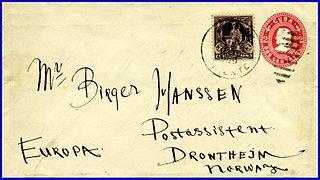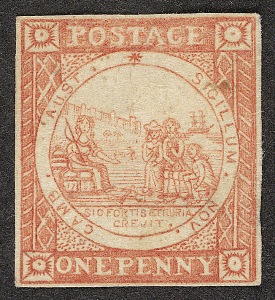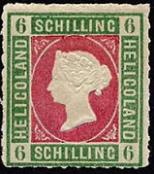
Philately is the study of postage stamps and postal history. It also refers to the collection and appreciation of stamps and other philatelic products. While closely associated with stamp collecting and the study of postage, it is possible to be a philatelist without owning any stamps. For instance, the stamps being studied may be very rare or reside only in museums.

Stamp collecting is the collecting of postage stamps and related objects. It is an area of philately, which is the study of stamps. It has been one of the world's most popular hobbies since the late nineteenth century with the rapid growth of the postal service, as a stream of new stamps was produced by countries that sought to advertise their distinctiveness through their stamps.
East Africa and Uganda Protectorates was the name used by the combined postal service of the British protectorates, British East Africa and Uganda, between 1 April 1903 and 22 July 1920.

A stamped envelope or postal stationery envelope (PSE) is an envelope with a printed or embossed indicium indicating the prepayment of postage. It is a form of postal stationery.
This is a list of philatelic topics.

Postage stamps and postal history of Great Britain surveys postal history from the United Kingdom and the postage stamps issued by that country and its various historical territories until the present day.

This is a survey of the postage stamps and postal history of New South Wales, a former British colony now part of Australia.

The British Central Africa Protectorate existed in the area of present-day Malawi between 1891 and 1907.

The postage stamps of Ireland are issued by the postal operator of the independent Irish state. Ireland was part of the United Kingdom of Great Britain and Ireland when the world's first postage stamps were issued in 1840. These stamps, and all subsequent British issues, were used throughout Ireland until the new Irish Government assumed power in 1922. Beginning on 17 February 1922, existing British stamps were overprinted with Irish text to provide some definitives until separate Irish issues became available within the new Irish Free State. Following the overprints, a regular series of definitive stamps was produced by the new Department of Posts and Telegraphs, using domestic designs. These definitives were issued on 6 December 1922, the day that the Irish Free State officially came into existence; the first was a 2d stamp, depicting a map of Ireland. Since then new images, and additional values as needed, have produced nine definitive series of different designs.

During the period when Heligoland was a British possession, about 20 postage stamps were issued between 1867 and 1890. There were up to eight printings of a single denomination and also a large volume of reprints which are known as the Berlin, Leipzig and Hamburg Reprints, respectively. The Berlin reprints are sometimes better quality than the originals. The reprints were done between 1875 and 1895. Consequently, many "old" collections contain reprints rather than originals. Some believe there were seven million reprints as compared to the known 1½ million originals, of which perhaps half were sold through the post office and the remainder sold to dealers when withdrawn from use. A few printings were never postally sold but nevertheless found their way into the hands of dealers. The stamps were printed by the Prussian State Printing Office in Berlin. They were denominated in the Hamburg Schilling until 1875, when both German Reich and British values appeared on each stamp issue. All are embossed with a silhouette of Queen Victoria excepting the four highest values which represent Heligoland escutcheons.

The postal history of Malta began in the early modern period, when pre-adhesive mail was delivered to foreign destinations by privately owned ships for a fee. The earliest known letter from Malta, sent during the rule of the Order of St John, is dated 1532. The first formal postal service on the islands was established by the Order in 1708, with the post office being located at the Casa del Commun Tesoro in Valletta. The first postal markings on mail appeared later on in the 18th century.

In philately, an imprinted stamp is a stamp printed onto a piece of postal stationery such as a stamped envelope, postal card, letter sheet, letter card, aerogram or wrapper. The printing may be flat upon the surface of the paper, or embossed with a raised relief. An imprinted stamp is also known as unadhesive stamp or indicium.

Herbert Edgar Weston, or H. Edgar Weston, was a stamp dealer in Stockwell, London, then Twickenham, who used the pseudonym Victor Marsh and who purchased Jean-Baptiste Moens' stock of philatelic literature after Moens' retirement in about 1907. Weston claimed to have the world's largest stock of philatelic literature for sale. He was also a prolific producer of philatelic covers using cut-outs from stamped to order postal stationery items. In 1907, Weston was a founder member of the Philatelic Literature Society.

This is a survey of the postage stamps and postal history of Gibraltar.
Antigua was discovered by Christopher Columbus, in 1493, and was named after the church of Santa Maria la Antigua in Seville. It was first settled in 1632. By the Treaty of Breda in 1667 it became a British Possession.
This is a survey of the postage stamps and postal history of British Bechuanaland.

This is a survey of the postage stamps and postal history of Saint Helena.

The British Library Philatelic Collections is the national philatelic collection of the United Kingdom with over 8 million items from around the world. It was established in 1891 as part of the British Museum Library, later to become the British Library, with the collection of Thomas Tapling. In addition to bequests and continuing donations, the library received consistent deposits by the Crown Agency and has become a primary research collection for British Empire and international history. The collections contain a wide range of artefacts in addition to postage stamps, from newspaper stamps to a press used to print the first British postage stamps.
The Board of Inland Revenue Stamping Department Archive in the British Library contains artefacts from 1710 onwards, and has come into existence through amendments in United Kingdom legislation.

The Halfpenny Yellow is the first postage stamp issued by the Crown Colony of Malta. Depicting Queen Victoria, it was only valid for local postage and it was originally issued on 1 December 1860. It was the only stamp issued by Malta for two and a half decades, and during this period various reprints were made with differences in colour shade, perforation and watermark. When control of Malta's postal service was transferred to the island's colonial government on 1 January 1885, the stamp was withdrawn and it was replaced by a set of definitive stamps.














